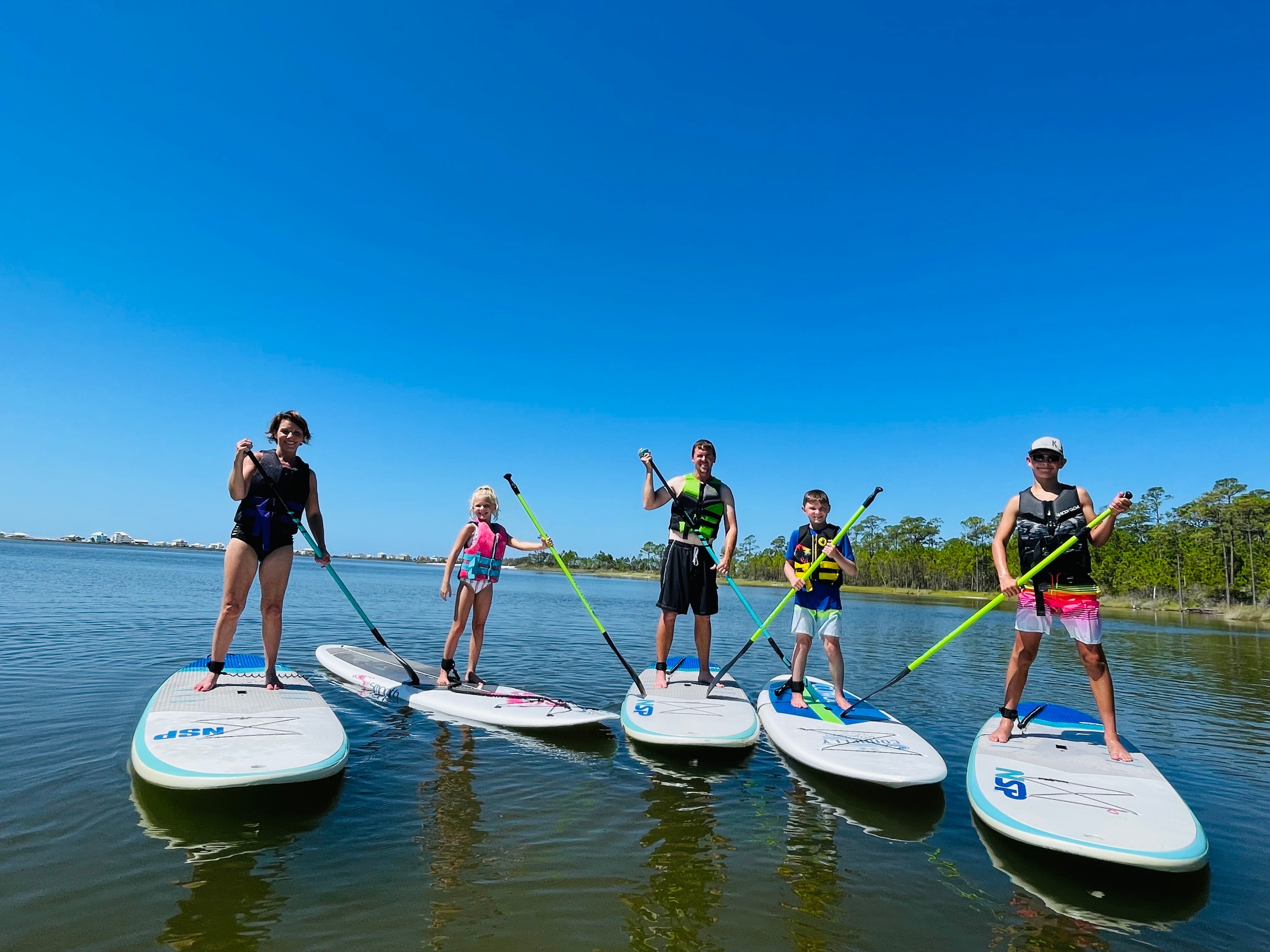Gliding Little Lagoon: Paddle-Boarding the Calm Heart of Gulf Shores
Shallow, sheltered, and perfect for beginners — paddle the protected waters of Little Lagoon
There’s a particular silence on Little Lagoon before the sun climbs fully over the barrier island — a low, marine hush broken only by the slap of a paddle and the sometimes-surreptitious exhale of a dolphin. Step off the sugar-sand ramp and your board flattens the water like a page waiting to be written on; reeds tilt like attentive readers. On mornings when the wind hasn’t learned its way into the day, the lagoon is a mirror that dares you to make the first mark.
Trail Wisdom
Go Early
Morning sessions avoid wind and produce the calmest water and the best light for photos.
Wear Reef Shoes
Shallow launches and seagrass flats are easier on your feet and give better traction when entering or exiting the board.
Bring a Dry Bag
Protect your phone, keys, and snacks from splash and the occasional intentional submersion.
Respect Wildlife Zones
Keep distance from nesting shorebirds and don’t paddle through dense seagrass beds to avoid habitat damage.
Local Knowledge
Hidden Gems
- •Paddle the narrow tidal channels at low tide to see juvenile fish in the seagrass
- •Walk the nearby Gulf State Park Pier at sunset for a different coastal perspective
Wildlife
Dolphins, Ospreys and Herons
Conservation Note
Commercial operators are permitted to work in the refuge and follow strict guidelines — stay on designated launch areas, avoid nesting sites, and minimize contact with seagrass to protect nursery habitat.
Little Lagoon and the bordering Bon Secour National Wildlife Refuge protect coastal marshes and dunes that have supported local fisheries and migratory bird routes for generations.
Seasonal Guide
spring
Best for: Mild temperatures, Migratory birdwatching, Calm winds
Challenges: Unpredictable showers, Occasional chilly mornings
Spring offers some of the calmest water and excellent bird activity — pack a light jacket for cool starts.
summer
Best for: Warm water, Long daylight, Family outings
Challenges: Higher humidity, Afternoon thunderstorms, Crowds on weekends
Summer is warm and sunny; aim for an early launch to beat storms and heat.
fall
Best for: Clear skies, Reduced bugs, Comfortable temperatures
Challenges: Occasional tropical weather in hurricane season
Fall’s cooler air makes paddling comfortable and the lagoon less crowded after peak summer.
winter
Best for: Quiet water, Off-season rates, Clear light
Challenges: Cooler water temperatures, Colder mornings
Winters are mild by northern standards but bring layers and a windproof jacket for comfort.
Photographer's Notes
What to Bring
Reef ShoesEssential
Protects feet on shallow flats and gives traction on wet boards.
Reef-Safe SunscreenEssential
Protects skin while minimizing harm to marine life and seagrass beds.
Light Wind Shell
Useful on cool mornings and breezy afternoons.
Dry Bag for Phone/KeysEssential
Keeps electronics and essentials dry while you paddle.
Common Questions
Do I need prior experience to join a lesson?
No — lessons are designed for beginners and will teach stance, stroke, balance and basic safety in about 75 minutes.
Is this suitable for children and older adults?
Yes — groups often include kids and grandparents; guests should be comfortable in the water and able to float or do light swimming.
What should I wear?
Swimwear or quick-dry clothing is best; bring a hat, sunglasses with a strap, and a light jacket for cool mornings.
Do you provide lifejackets and boards?
Yes — high-quality rigid SUPs, adjustable paddles, leashes, lifejackets and dry bags are provided by the operator.
Can we mix kayaks and SUPs in one booking?
Yes — simply book each craft separately for the same time and launch location so your group can paddle together.
What is the cancellation policy or bad-weather plan?
Operators typically reschedule or offer refunds for unsafe conditions like high winds or storms; check the booking confirmation for specific policies.
What to Pack
Water bottle (rehydration), reef shoes (shore entries), reef-safe sunscreen (skin and environment protection), light wind shell (cool mornings/wind)
Did You Know
Little Lagoon’s seagrass beds serve as critical nursery habitat for juvenile game fish like redfish and spotted seatrout — those grasses are essential to the Gulf ecosystem.
Quick Travel Tips
Book a morning slot, check wind forecasts, bring reef shoes, confirm meeting location and time with operator
Local Flavor
After your paddle, head to The Hangout or Lulu’s at Homeport Marina for fresh Gulf seafood, cold local beers, and live music; if you prefer something quieter, grab oysters and a sunset view near the Gulf State Park Pier.
Logistics Snapshot
Closest airport: Mobile Regional Airport (MOB, ~45 miles). Driving distance: ~5–10 minutes from Gulf State Park. Cell service: Generally OK near launch but spotty in refuge pockets. Permits: Commercial guides operate under a refuge permit; individual visitors do not need a special permit but must follow refuge rules.
Sustainability Note
This experience operates inside or adjacent to a National Wildlife Refuge — pack out all trash, avoid disturbing nesting birds or seagrass beds, and use reef-safe sunscreen to protect marine life.
